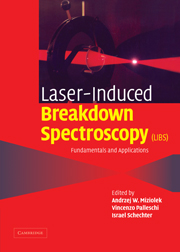Book contents
- Frontmatter
- Contents
- List of contributors
- Preface
- 1 History and fundamentals of LIBS
- 2 Plasma morphology
- 3 From sample to signal in laser-induced breakdown spectroscopy: a complex route to quantitative analysis
- 4 Laser-induced breakdown in gases: experiments and simulation
- 5 Analysis of aerosols by LIBS
- 6 Chemical imaging of surfaces using LIBS
- 7 Biomedical applications of LIBS
- 8 LIBS for the analysis of pharmaceutical materials
- 9 Cultural heritage applications of LIBS
- 10 Civilian and military environmental contamination studies using LIBS
- 11 Industrial applications of LIBS
- 12 Resonance-enhanced LIBS
- 13 Short-pulse LIBS: fundamentals and applications
- 14 High-speed, high-resolution LIBS using diode-pumped solid-state lasers
- 15 Laser-induced breakdown spectroscopy using sequential laser pulses
- 16 Micro LIBS technique
- 17 New spectral detectors for LIBS
- 18 Spark-induced breakdown spectroscopy: a description of an electrically generated LIBS-like process for elemental analysis of airborne particulates and solid samples
- Index
- References
7 - Biomedical applications of LIBS
Published online by Cambridge University Press: 08 August 2009
- Frontmatter
- Contents
- List of contributors
- Preface
- 1 History and fundamentals of LIBS
- 2 Plasma morphology
- 3 From sample to signal in laser-induced breakdown spectroscopy: a complex route to quantitative analysis
- 4 Laser-induced breakdown in gases: experiments and simulation
- 5 Analysis of aerosols by LIBS
- 6 Chemical imaging of surfaces using LIBS
- 7 Biomedical applications of LIBS
- 8 LIBS for the analysis of pharmaceutical materials
- 9 Cultural heritage applications of LIBS
- 10 Civilian and military environmental contamination studies using LIBS
- 11 Industrial applications of LIBS
- 12 Resonance-enhanced LIBS
- 13 Short-pulse LIBS: fundamentals and applications
- 14 High-speed, high-resolution LIBS using diode-pumped solid-state lasers
- 15 Laser-induced breakdown spectroscopy using sequential laser pulses
- 16 Micro LIBS technique
- 17 New spectral detectors for LIBS
- 18 Spark-induced breakdown spectroscopy: a description of an electrically generated LIBS-like process for elemental analysis of airborne particulates and solid samples
- Index
- References
Summary
Introduction
In this chapter, applications of laser-induced breakdown spectroscopy (LIBS) to the analysis of biological and medical samples are outlined. The range of samples includes calcified tissue materials (e.g. teeth, bones, sea shells), soft tissue materials (e.g. human skin, plant parts like leaves and wood), and – to a limited extent – bio-fluids (e.g. blood). Specifically, applications providing spatial resolution information (lateral and/or depth) of elemental concentration distributions are discussed; no other technique provides such information with the ease of the method of LIBS. Strong efforts have been made to link this information with nutritional and environmental influences. Throughout the survey, the problem of reference standards, required for fully quantitative analysis, is addressed.
The technique of LIBS offers a simple and fast method of elemental analysis. Any material – solid, liquid or gaseous – can be analyzed, and no (or only very little) sample preparation is needed, as is being highlighted in other chapters of this book. Detection limits for solid samples are, in favorable cases, of the order of a few parts per million (p.p.m.). While this may be inferior to other methods of analysis one has to keep in mind that LIBS analysis can be undertaken directly from the solid sample, often in situ and at “remote” locations, and even in vivo analysis may be possible, when dealing with living organisms.
- Type
- Chapter
- Information
- Laser Induced Breakdown Spectroscopy , pp. 282 - 313Publisher: Cambridge University PressPrint publication year: 2006
References
- 1
- Cited by



